Facial Nerve Palsy in a Female Teenager
Bell palsy is a facial nerve palsy thought to be the result of a lower motor neuron lesion caused by an autoimmune response. Viral infections are commonly implicated.
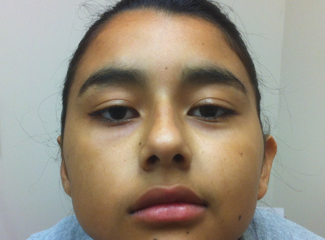
Figure 1
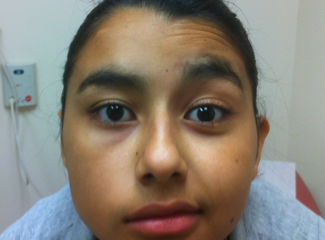
Figure 2
A 14-year-old girl presented to our office with a 1-week history of right-sided facial numbness. She woke up one morning with right ear pain, which was followed the next day by progressive paresthesia of the right side of her face. The patient denied any recent head injury and she was otherwise asymptomatic. Her vital signs were within normal limits for her age. Examination of the face revealed slight asymmetry, with disappearance of the nasolabial fold on the right side (Figure 1). The findings for the rest of her neurologic examination were within normal limits. Based on this assessment, a diagnosis was made of acquired idiopathic, unilateral facial paralysis (Bell Palsy).
The annual prevalence of facial nerve palsy in the general population is between 15 and 40 per 100,000,1 with approximately half of the cases diagnosed as Bell palsy.2 In children the incidence of unilateral facial nerve palsy is lower than in adults, between 2.7 and 10.1 per 100,000.1 Bell’s palsy is thought to be the result of a lower motor neuron lesion of the facial nerve caused by an autoimmune response. Viral infections are the most likely triggers of the autoimmune reaction and herpes simplex virus is among the most common viral etiologies.3 Any lesion of the facial nerve after it exits the brainstem causes unilateral impairment of some degree of any area of the face, while lesions above the brainstem (upper neuron) will also produce unilateral involvement but spare the forehead, because this area receives bilateral innervation via the corticobulbar tracts.
The onset is abrupt over 1 to 2 days and the typical signs include flattening of the forehead and nasolabial fold on the affected side, decreased forehead movement, inability to close the eye, and eyebrow sagging; the mouth appears drawn toward the unaffected side.4 Associated symptoms may include loss of taste, hyperacusis, and decreased tearing on the affected side. Facial asymmetry can be appreciated, as it was in our examination, by asking the patient to frown (Figure 2), close the eyes (Figure 3), smile or show the teeth (Figure 4), and pucker the lips. The presence of painful vesicles in the external auditory canal in addition to the facial symptoms of Bell palsy is the hallmark of Ramsey Hunt syndrome. Ramsey Hunt syndrome is similar to Bell palsy but is caused by reactivation of varicella-zoster virus.5 Careful examination of the ear, parotid gland, mastoid, and neck area will help rule out other etiologies of facial nerve palsy, while assessment of hearing, taste, lacrimation, and salivation helps localize the lesion.
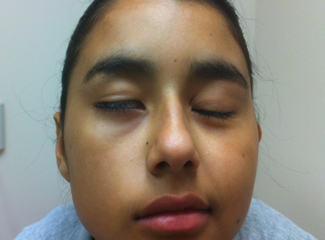
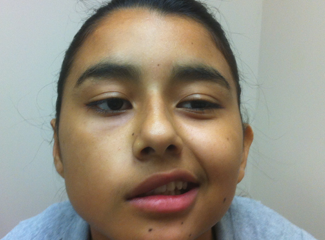
Figures 3 and 4
Bell palsy is a diagnosis of exclusion and it encompasses several criteria6,7:
• Acute onset, over several days, with a progressive course and maximum weakness reached in about 3 weeks or less, followed by progressive recovery over a period of about 6 months
• Diffuse involvement of all the distal branches of the facial nerve
• Occasional prodrome of ear pain and hyperacusis can be present
Diagnostic studies are necessary for patients with atypical signs (eg, other cranial nerves involved), head injury, otitis media, or acute mastoiditis, or if a neoplasm is suspected.4
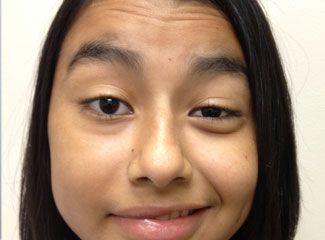
Figure 5
In adults early use of corticosteroids has been shown to improve the likelihood of recovery,8 and data from adults were extrapolated and adapted for use in children. Antiviral treatment geared toward herpes simplex virus appears beneficial in adult patients with severe paralysis.9 In children, there are no studies to demonstrate the efficacy of the above treatments.10 There are no formal recommendations concerning corticosteroid and antiviral use in children. Eye care with artificial tears during the day, and antibiotic ointment along with patching during the night, are important to prevent the development of corneal abrasions. Physical therapy may help speed up improvement of facial muscle tone and strength.11
Incomplete lesions tend to resolve faster and recover completely. The House-Brackman facial nerve grading system12 was created to clinically quantify facial nerve function. It is used to monitor lesion progression as well as to predict prognosis based on the function (movement) of specific facial reference points. It is a 6-point grading scale, with grade 1 (no impairment) and grade 2 (mild dysfunction) having a better prognosis for recovery than grade 5 (severe dysfunction) or grade 7 (total paralysis). On presentation, our patient was assigned grade 4.
The patient was treated with prednisone 10 mg daily for 5 days and acyclovir 400 mg 5 times a day for 1 week, followed by a course of physical therapy.
At the 2-month follow-up, there was improvement noted in movement of the forehead and in the patient’s ability to close the affected eye (Figure 5). She was given a House-Brackman grade 3.
References
1. Pavlou E, Gkampeta A, Arampatzi M. Facial nerve palsy in childhood. Brain Dev. 2011;33:644-650.
2. Jackson CG, von Doersten PG. The facial nerve. Current trends in diagnosis, treatment, and rehabilitation. Med Clin North Am. 1999;83:179-195.
3. Greco A, Gallo A, Fusconi M, et al. Bell’s palsy and autoimmunity. Autoimmun Rev. 2012 Jun 8; [Epub ahead of print]. http://www.ncbi.nlm.nih.gov/pubmed/22684016
4. Shargorodsky J, Lin HW, Gopen Q. Facial nerve palsy in the pediatric population. Clin Pediatr (Phila). 2010;49:411-417.
5. Kansu L, Yilmaz I. Herpes zoster oticus (Ramsey Hunt syndrome) in children: case report and literature review. Int J Pediatr Otorhinolaryngol. 2012;76:772-776.
6. Tiemstra JD, Khatkhate N. Bell’s palsy: diagnosis and management. Am Fam Physician. 2007;76:997-1002.
7. Gilden DH. Clinical practice. Bell's Palsy. N Engl J Med. 2004;351:1323-1331.
8. Adour KK, Ruboyianes JM, Von Doersten PG, et al. Bell's palsy treatment with acyclovir and prednisone compared with prednisone alone: a double-blind, randomized, controlled trial. Ann Otol Rhinol Laryngol. 1996;105:371-378.
9. Hato N, Yamada H, Kohno H, et al. Valacyclovir and prednisolone treatment for Bell’s palsy: a multicenter, randomized, placebo-controlled study. Otol Neurotol. 2007;28:408-413.
10. Pitaro J, Waissbluth S, Daniel SJ. Do children with Bell’s palsy benefit from steroid treatment? A systematic review. Int J Pediatr Otorhinolaryngol. 2012;76:921-926.
11. Teixeira LJ, Valbuza JS, Prado GF. Physical therapy for Bell’s palsy (idiopathic facial paralysis). Cochrane Database Syst Rev. 2011;12:CD006283.
12. House JW, Brackmann DE. Facial nerve grading system. Otolaryngol Head Neck Surg. 1985;93:146-147.
Recognize & Refer: Hemangiomas in pediatrics
July 17th 2019Contemporary Pediatrics sits down exclusively with Sheila Fallon Friedlander, MD, a professor dermatology and pediatrics, to discuss the one key condition for which she believes community pediatricians should be especially aware-hemangiomas.